John King, Sr., ca. 1770 - 1841
John King, Jr., 1797 - 1876
Thomas Davies King, 1819 - 1884
Henry Payne Coombs, 1826 - 1908
John King and Son,
John King,
King and Coombs,
and
Thomas D. King
successors to
Richard and Charles Beilby
and
Joshua Springer
by Brian Stevenson
last updated September, 2023
Originally from London, John King, Senior, worked for several years in Bristol at the Beilby brothers' optical and scientific instrument firm. He acquired that shop in 1821, then brought his son on board in the partnership of John King & Son. The two men had a falling out in 1831, whereupon the partnership was dissolved, and with John Sr. retaining ownership and John Jr. working as an employee. Soon after John Sr.'s death in 1845, John Jr. sold the business to his son, Thomas. The latter man ended the business ca. 1858, and emigrated to Canada. King's shop at the corner of Denmark Street and St. Augustine’s Parade was purchased by two former employees, Husbands and Clarke, and his second shop, at 2 Clare Street, was acquired by Thomas King's son-in-law, James Blake Gardiner (1836-1909).
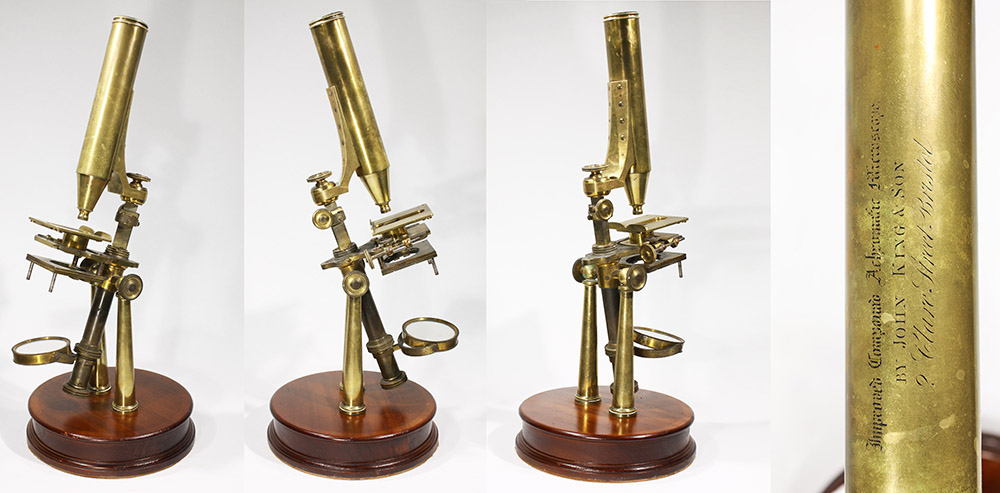
Figure 1. A ca. 1820s microscope engraved “improved compound achromatic microscope John King & Son, 2 Clare Street, Bristol”. This unique microscope is mounted on a mahogany base, and stands over 21 inches / 52 cm tall. Adapted by permission from a private collection.
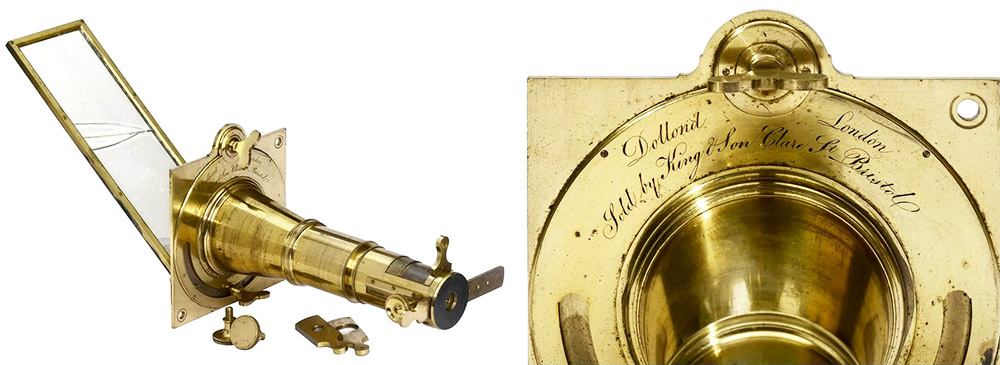
Figure 2.
Solar microscope that was manufactured by Dollond, and marked as having been retailed by King and Son (ca. 1821 - 1831). Adapted for nonprofit, educational purposes from an internet auction site.
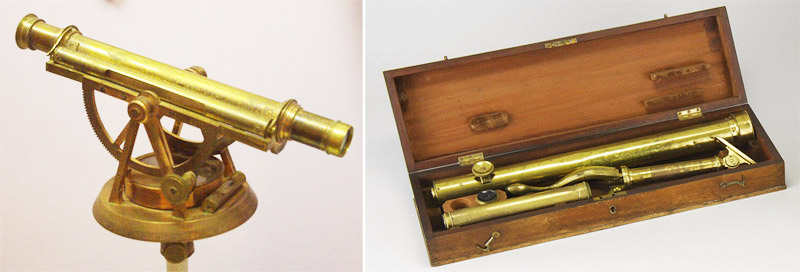
Figure 3. Theodolite and cased telescope, both signed by John King. The signatures date them to between 1831, when the King and Son partnership ended, and ca. 1845-1851, when John Jr. passed the business to his son, Thomas. Adapted for nonprofit, educational purposes from the Bath Preservation Trust and an internet auction site.
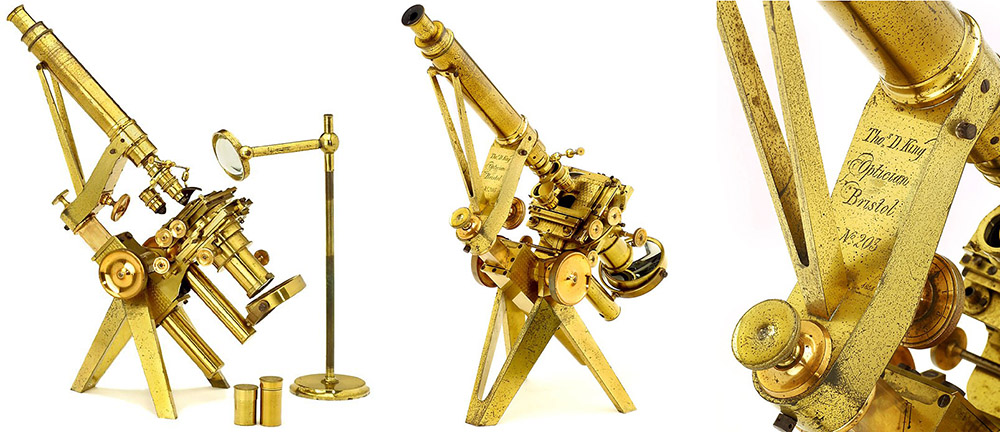
Figure 4.
A large and solid microscope by Thomas D. King, serial number 203. It seems to match the description of a microscope that King showed at the 1861 London Exposition, "Compound achromatic
microscope mounted on a pyramidal tripod, with mechanical stage, traversing in rectangular planes by micrometer screws, achromatic condenser... In this microscope the weight is equally
distributed over the base, and when inclined at its working angle the chief portion is brought below the point of suspension. Adapted for nonprofit, educational purposes from https://www.antiquemicroscopesandslides.com/thomas-davies-king-paris-exposition-1855.
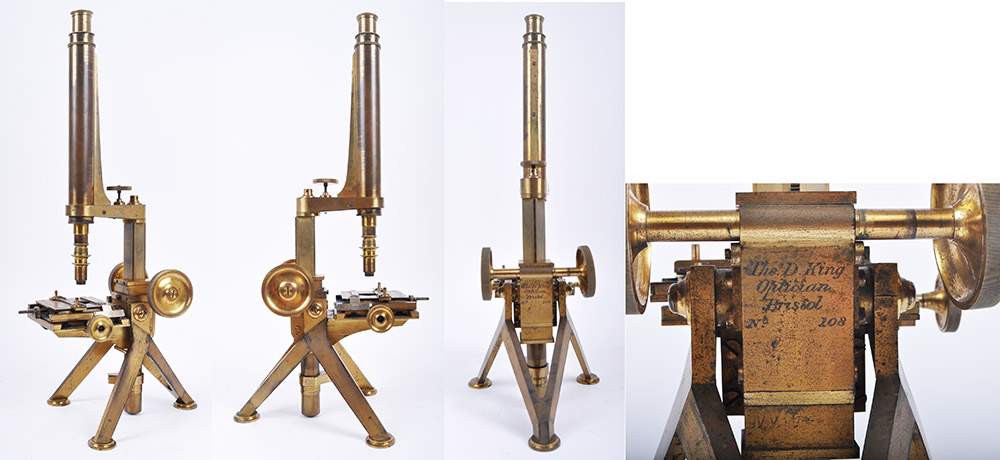
Figure 5.
A smaller bar-limb microscope, on a tripod base, by Thomas D. King. Serial number 108. King evidently sold this and similar models wholesale to other retailers, such as Joseph Wellington and William Ruck. Images adapted for nonprofit, educational purposes from an internet auction site.
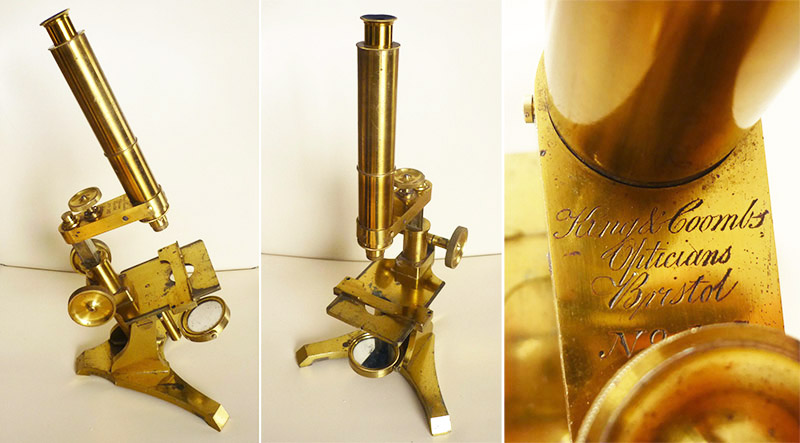
Figure 6.
A microscope made circa 1852 by King and Coombs. It bears serial number 167, suggesting production between the microscopes shown in Figures 4 and 5, above. Adapted for nonprofit, educational purposes from an internet auction site.

Figure 7.
A barometer and an ivory ruler, both made ca. 1851 by King and Coombs. Adapted for nonprofit, educational purposes from internet auction sites.
John King, Senior, established his optical and scientific instrument business in 1821. He had been foreman to Charles and Richard Beilby, who operated a scientific instrument business at 2 Clare Street, Bristol. The Beilbys had opened their business in 1808, taking over the business of Joshua Springer. King's successors, Husbands and Clarke, often noted in advertisements that their business was established in 1762, a reference to their predecessor Springer. Examples of instruments produced by Springer and the Beilbys are shown at the end of this essay.
Soon after opening his shop, John Sr. brought his son, John Jr., into the business, which then operated as King and Son (Figure 7). A substantial conflict arose between the elder and younger Kings, due, in part, to John Jr. abandoning his wife and children for another woman in 1831. The partnership was dissolved that year, with the father retaining sole ownership of the business (Figure 8).
John Junior evidently made up with his wife, Harriet, as the couple had a daugther, also named Harriet, in September, 1832. The daughter's baptism record states that they were then living at Clare Street, and that John Jr. worked as an "optician". An 1835 electoral register included "King, jun. John, optician, Clare street". Thus, it appears that the father and son also resolved their differences to some extent.
John King Sr. and his wife, Elizabeth, had retired to a cottage in Chew Magna, Somerset by the time of the 1841 census. Nonetheless, he retained ownership of the shop in Bristol, with John Jr. running the day-to-day operations (Figure 9). When John Sr. died in 1845, he left ownership of the business to John Jr.
John King Jr. did not keep the business for long. The 1851 national census listed his occupation as "commission agent", while the shop at 2 Clare Street was operated by his eldest son, Thomas Davies King. John then retired to Bedminster, Somerset. He died there on March 30, 1876.
Thomas King exhibited three microscopes and an illuminator at the 1851 Great Exhibition of London. These were described as, “Compound achromatic microscope mounted on a pyramidal tripod, with mechanical stage, traversing in rectangular planes by micrometer screws, achromatic condenser, polariscope, double refracting goniometer, cobweb micrometer and other eye-pieces, insect forceps, and various accessories. In this microscope the weight is equally distributed over the base, and when inclined at its working angle the chief portion is brought below the point of suspension; the traversing stage has divided scales and verniers, whereby admeasurements can be accurately determined” (see Figure 3), a “Student's compound achromatic and single microscope” (see Figure 4), and an “Improved spherical prismatic illuminator, for transparent and opaque microscopic objects, enabling the rays of light to be thrown either obliquely or vertically”. He was awarded an Honourable Mention for “workmanship ... of the first order”.
The shop at 2 Clare Street was also Thomas King's family home. During the early 1850s, a second shop was opened, on the corner of Denmark Street and St. Augustine’s Parade. Both premises appear to have been operated simultaneously.
T.D. King briefly formed a partnership with Henry Payne Coombs (1826-1908), operating as King and
Coombs (Figures 5 and 6). The partnership was dissolved in February, 1853, as listed in The London Gazette: "Notice is hereby given, that the Partnership heretofore carried on by us the undersigned. Thomas Davies King and Henry Payne Coombs, at No. 2, Clare street, in the city of Bristol, as Opticians and Mathematical Instrument Makers, under the style or firm of King and Coombs, was this day dissolved by mutual consent". Being that only King was listed as exhibiting at London in 1851, the partnership appears to have existed for less than two years. Coombs then established an independent cutlery and ironmonger business in nearby Frome.
King exhibited two models of achromatic microscopes and a photographic chamber at the 1855 Paris International Exhibition.
Thomas King filed for bankruptcy protection in 1856, as reported by The London Gazette in March of that year: “Notice is hereby given, that Thomas Davies King, of the city of Bristol, Optician and Mathematical Instrument Maker, did by deed, bearing date the 18th day of February, 1856, assign unto Henry Reed, of High-street, in the said city of Bristol, Accountant, and Charles McMillan,
of Wine-street, in the said city of Bristol, Tailor, all the estate and effects of him the said Thomas Davies King, upon the trusts therein mentioned, for the benefit of all the creditors of the said Thomas Davies King; and the said deed was duly executed by the said Thomas Davies King, Henry Reed, and Charles McMillan, on the said 18th day of February, 1856; and the execution of the said
deed by the said. Thomas Davies King, Henry Reed, and Charles McMillan, was attested by Peregrine Hammonds, of No. 30, Broad-street, in the said city of Bristol, Attorney-at-Law; and the said indenture now lies at the office of the said Peregrine Hammonds, at Bristol aforesaid, for the perusal and execution by the creditors of the said Thomas Davies King; and who will be excluded from all benefit under the said deed unless they execute the same within two months from the date thereof”.
The Clare Street shop was passed to King's son-in-law, James Blake Gardiner (1836-1909). Two former journeymen, Henry Husbands (ca. 1824 – 1900) and William Clarke (ca. 1810 – 1873) purchased the shop on the corner of Denmark Street and St. Augustine’s Parade, partnering as "Husbands and Clarke".
Thomas King moved to Canada in 1858, where he "was employed for some years as a meteorologist by the Grand Trunk Railway. It has been stated that he made a series of valuable experiments on the Victoria Bridge during its construction with instruments invented and manufactured by himself. However his principal interests seem to have been in the fields of art and literature. He was a founding member of The Montreal Sketching Club and its meetings were held at his home, 26 Beaver Hall Hill. In literature his special concern was Shakespeare ... He was an ardent collector of all works relating to Shakespeare and was one of the founders of the Montreal Shakespeare Club. In 1864, on the occasion of the 300th anniversary of Shakespeare's birth, he secured the endowment of a Shakespeare Gold Medal at McGill University. ... The Montreal Shakespeare Club called him 'The father of Shakespearean study in Montreal'. In an editorial in 'The Gazette' published two days after his death, he was paid the still higher compliment of having been 'perhaps the best Shakespearean scholar in Canada'." Thomas died at his home on November 8, 1884, at the age of 66.
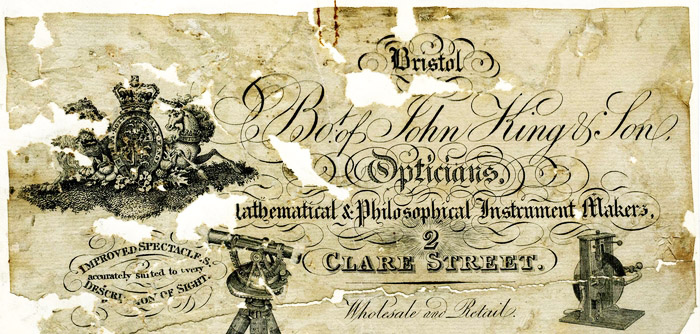
Figure 8.
John King and Son trade label, ca. 1821-1831. Adapted for nonprofit, educational purposes from http://museums.bristol.gov.uk/details.php?irn=131155 .
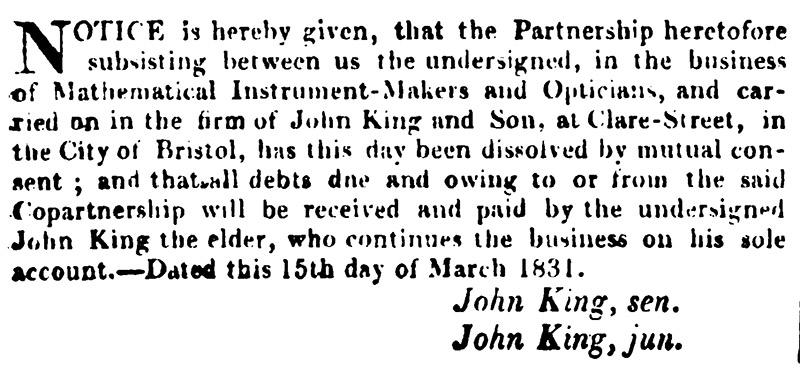
Figure 9. 1831 notice of dissolution of John King and Son. From "The London Gazette".

Figure 10.
Entry for John King from the 1839 "Robson's Directory".
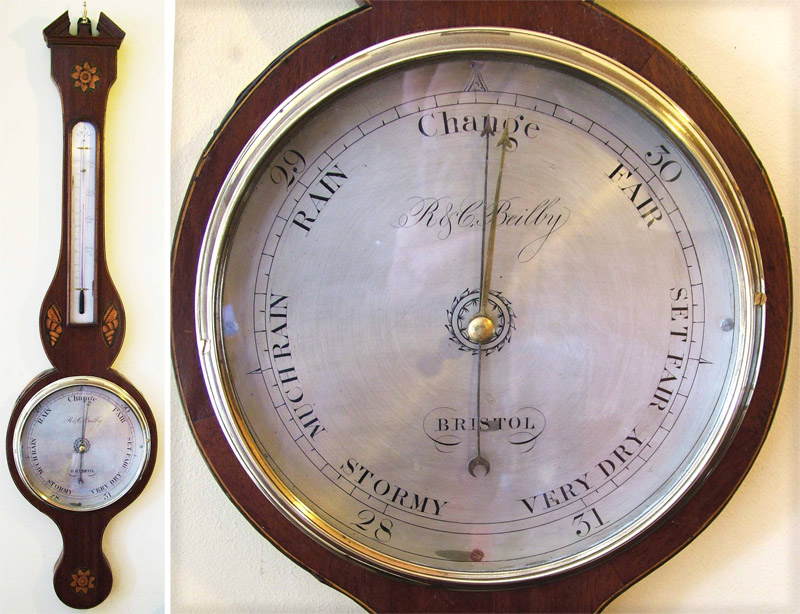
Figure 11.
A ca. 1810 barometer by Richard and Charles Beilby, predecessors to John King. The whole instrument is shown on the left, and an enlargement of the dial is on the right. Adapted for nonprofit, educational purposes from an internet auction site.
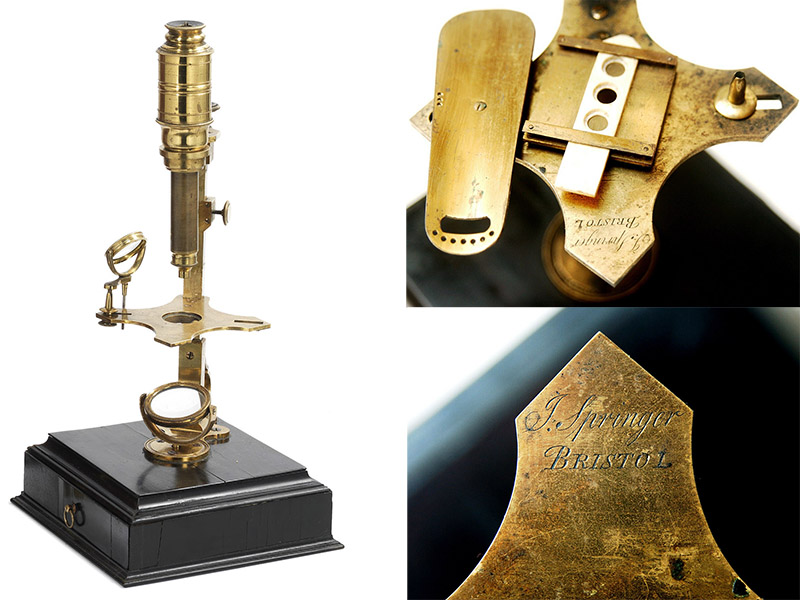
Figure 12.
A ca. 1770 Cuff-type compound microscope by Joshua Springer, predecessor to Richard and Charles Beilby. Enlargements of the stage are shown on the right. Adapted for nonprofit, educational purposes from an internet auction site.
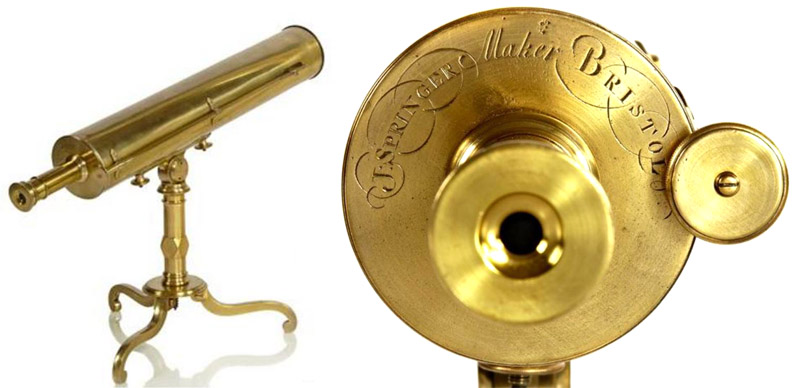
Figure 13.
A reflecting telescope by Joshua Springer, ca. 1790. An enlargement of the eyepiece is on the right. Adapted for nonprofit, educational purposes from an internet auction site.
Resources
Arrowsmith’s Dictionary of Bristol (1884) Optical works, J.W. Arrowsmith, Bristol, page 149
Bath Preservation Society (accessed January 2012) Picture and information on theodolite made by John King, <>http://www.bath-preservation-trust.org.uk/index.php?id=123
Bensley, E.H. (1976) The book that Dr. Osler lost, Osler Library Newsletter, McGill University, Montreal, June issue (includes a description of Thomas Davies King's time in Canada)
The Bristol Mercury (1858) Advertisements from Husbands and Clarke, beginning April 24 and running weekly for at least three months
England census and other records, accessed through ancestry.com
Exposition Universelle, 1855. Catalogue des Objets Exposes dans la Section Britannique de l’Exposition (1855) "402 KING, T.D., a Bristol, A. - Microscope achromatique; microscope achromatique portatif. Chambre obscure poui’ la photographie", Chapman and Hall, London, page 23
King, Thomas D. (1875) Bacon Versus Shakespeare: a Plea for the Defendant, Lovell, Montreal
London Gazette (1831) Dissolution of the partnership between John King Sr. and John King Jr., March, page 526
London Gazette (1853) Dissolution of the partnership between Thomas D. King and Henry P. Coombs, February 11
London Gazette (1856) Settlement of accounts of Thomas D. King, March 11
Morrison-Low, Alison D. (2007) Making Scientific Instruments in the Industrial Revolution, Ashgate, Aldershot, Hampshire, pages 52-53 and 60
Official Catalogue of the Great Exhibition (1851) entry 287. King, Thomas D., Bristol
Official Catalogue: Industrial Department (1862) Class 13, Philosophical Instruments,
entries 3003 and 3009, Her Majesty’s Commissioners, London
Probate of the will of John Kink Junior (1876) "The Will of John King late Upper Knowle in the Parish of Bedminster in the County of Somerset Gentleman who died 30 March 1876 at Upper Knowle was proved at Bristol by Elizabeth King of Upper Knowle Spinster the Daughter and James Blake Gardiner of 7 Guinea-street in the City of Bristol Accountant the Executors. Effects under £200."
Robson's Directory (1839) page 27
Shakespeariana (1883) Obituary of Thomas D. King, Vol. 2, pages 35-36












